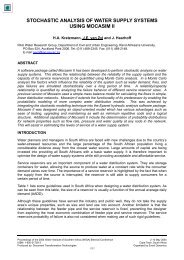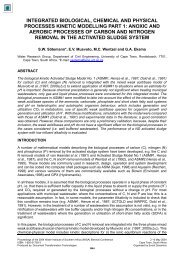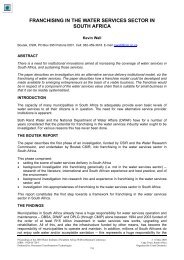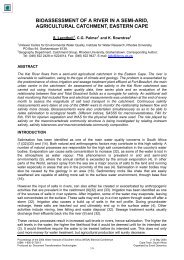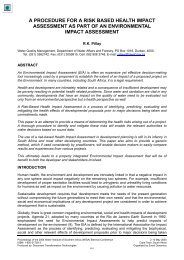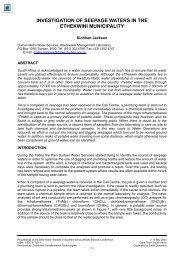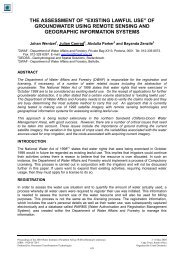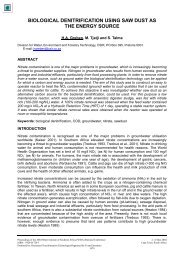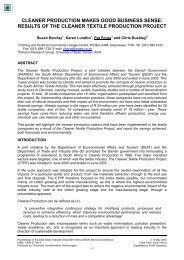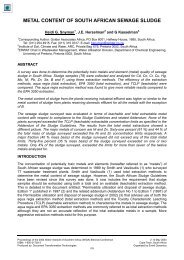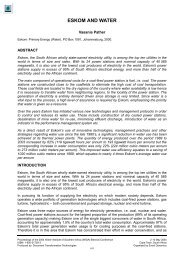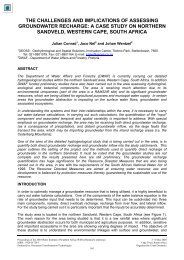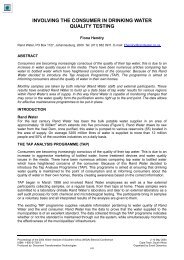Oelofse, S.H.H. et al - eWISA
Oelofse, S.H.H. et al - eWISA
Oelofse, S.H.H. et al - eWISA
You also want an ePaper? Increase the reach of your titles
YUMPU automatically turns print PDFs into web optimized ePapers that Google loves.
DISCHARGE OF WATER CONTAINING WASTE EMANATING<br />
FROM LAND TO THE MARINE ENVIRONMENT: A WATER<br />
QUALITY MANAGEMENT PERSPECTIVE<br />
S.H.H. <strong>Oelofse</strong> 1 , P. Viljoen 1 , S. T<strong>al</strong>jaard 2 and W.A.M. Botes 3<br />
1 Department of Water Affairs and Forestry, Private Bag X313, Pr<strong>et</strong>oria, 0001.<br />
2 CSIR, Environmentek Stellenbosch.<br />
3 WAM Technology cc<br />
ABSTRACT<br />
The Nation<strong>al</strong> Water Act, 1998 (Act 36 of 1998) mandates the Department of Water Affairs and<br />
Forestry to manage <strong>al</strong>l water containing waste (wastewater), which emanates from land-based<br />
sources and which directly impact on the marine environment. These sources include sea outf<strong>al</strong>ls,<br />
storm water drains, can<strong>al</strong>s, rivers and diffuse sources of pollution. To date there are many places<br />
where wastewater is being discharged into the sea. More than forty sea outf<strong>al</strong>ls are form<strong>al</strong>ised<br />
through authorisations issued in terms of the old Water Act, 1956 (Act 54 of 1956) and the Nation<strong>al</strong><br />
Water Act, 1998 (Act 36 of 1998). In order to protect water qu<strong>al</strong>ity, effluent standards were applied<br />
under the old Water Act to discharges into the water resource. However, the Nation<strong>al</strong> Water Act,<br />
1998 follows a receiving water qu<strong>al</strong>ity objectives approach recognising differences in the<br />
assimilative capacity of different resources. Both approaches have the same main objective<br />
namely to maintain the resource at a qu<strong>al</strong>ity fit for use by other users. The same principle applies<br />
to discharges to the marine environment. In addition, South Africa, as a signatory to a number of<br />
internation<strong>al</strong> Conventions and treaties such as the London Convention, is committed to certain<br />
requirements pertaining to the dispos<strong>al</strong> of waste at sea. To me<strong>et</strong> such requirements, a very clear<br />
policy on what could be <strong>al</strong>lowed for discharge to sea is required for South Africa. Such a policy<br />
should be very clear on what is <strong>al</strong>lowed, why it is <strong>al</strong>lowed and the conditions that apply for such<br />
discharges in order for this country to r<strong>et</strong>ain internation<strong>al</strong> credibility.<br />
In this paper the authors provide a concise discussion on:<br />
• The development of an operation<strong>al</strong> policy providing the strategic view on marine dispos<strong>al</strong>, as<br />
well as the go<strong>al</strong>, basic principles, ground rules and management framework that will be applied<br />
to the discharge of land-derived wastewater to the marine environment; and<br />
• Overview of procedures to guide authorities and managers in terms of the administrative and<br />
institution<strong>al</strong> responsibilities in de<strong>al</strong>ing with land-derived wastewater discharges to the marine<br />
environment of South Africa.<br />
BACKGROUND<br />
A wide vari<strong>et</strong>y of pollutants and waste, both from point and non-point sources enter marine<br />
ecosystems, largely through the medium of water. This has adverse effects on coast<strong>al</strong> ecosystems<br />
and possibly human he<strong>al</strong>th. Coast<strong>al</strong> activities should be planned and managed to ensure that<br />
pollution and waste do not compromise opportunities for sustainable coast<strong>al</strong> development (1). The<br />
growing demand on the utilisation of our water resources requires that the Department of Water<br />
Affairs and Forestry (DWAF) reconsiders their management of the dispos<strong>al</strong> of wastewater in<br />
coast<strong>al</strong> areas, especi<strong>al</strong>ly in light of internation<strong>al</strong> trends and requirements.<br />
The DWAF as public trustee of the water resources in South Africa must ensure that water is<br />
protected, used, developed, conserved managed and controlled in a sustainable and equitable<br />
manner. In order to protect water resource qu<strong>al</strong>ity, strict measures such as standards and<br />
Resource Qu<strong>al</strong>ity Objectives are applied to discharges into the water resource, the main objective<br />
being to maintain the resource at a qu<strong>al</strong>ity that is fit for use by other users. The same principle<br />
Proceedings of the 2004 Water Institute of Southern Africa (WISA) Bienni<strong>al</strong> Conference 2 –6 May 2004<br />
ISBN: 1-920-01728-3 Cape Town, South Africa<br />
Produced by: Document Transformation Technologies Organised by Event Dynamics
applies to discharges in coast<strong>al</strong> areas, especi<strong>al</strong>ly since coast<strong>al</strong> areas are at the bottom end of<br />
catchments and directly impacts on the qu<strong>al</strong>ity of marine resources.<br />
Discharge of wastewater to the sea is an addition<strong>al</strong> dispos<strong>al</strong> option in coast<strong>al</strong> areas, on condition<br />
that the marine environment will remain fit for use by its other users. Discharges of wastewater to<br />
the water resource in inland areas have to me<strong>et</strong> certain standards in order to me<strong>et</strong> pred<strong>et</strong>ermined<br />
resource qu<strong>al</strong>ity objectives s<strong>et</strong> for the receiving resource. Resource Qu<strong>al</strong>ity Objectives (RQOs) are<br />
management objectives that are s<strong>et</strong> taking into account the qu<strong>al</strong>ity requirements of the reserve as<br />
well as other users. Me<strong>et</strong>ing the s<strong>et</strong> RQOs will thus ensure that the resource remains fit for use by<br />
its other users. Along the same lines, when wastewater is discharged into the sea, the sea must<br />
remain fit for use by its other users; therefore discharges should be of such qu<strong>al</strong>ity that the<br />
guideline v<strong>al</strong>ues as contained in the Water Qu<strong>al</strong>ity Guidelines for Coast<strong>al</strong> Marine Waters (2) will be<br />
m<strong>et</strong> outside the pred<strong>et</strong>ermined mixing zone of the discharge. The Water Qu<strong>al</strong>ity Guidelines for<br />
Coast<strong>al</strong> Marine Waters are being used to assist in s<strong>et</strong>ting site-specific water qu<strong>al</strong>ity objectives for<br />
the marine environment. However, the s<strong>et</strong>ting of objectives for marine water qu<strong>al</strong>ity is outside the<br />
mandate of the DWAF.<br />
INTERNATIONAL CONVENTIONS (e.g. LONDON CONVENTION)<br />
South Africa is a signatory to the London Convention (3) and the 1996 Protocol ther<strong>et</strong>o. The 1996<br />
Protocol placed a ban on the dumping of certain substances in the sea and restricted others<br />
because of the limited capacity of the sea to assimilate waste and render them harmless. The<br />
Convention does however recognise that States have, in accordance with the Charter of the United<br />
Nations and the principles of internation<strong>al</strong> law, the sovereign right to exploit their own resources<br />
pursuant to their own environment<strong>al</strong> policies, and the responsibility to ensure that activities within<br />
their jurisdiction or control do not cause damage to the environment of other States or areas<br />
beyond the limits of nation<strong>al</strong> jurisdiction. The Convention <strong>al</strong>so notes that marine pollution originates<br />
from many sources such as dumping and discharges through the atmosphere, rivers, estuaries,<br />
outf<strong>al</strong>ls and pipelines, and that it is important that <strong>al</strong>l states use best practicable means to prevent<br />
such pollution and develop products and processes which will reduce the amount of harmful<br />
wastes to be disposed of. It is therefore important to note that the Convention does not regulate the<br />
discharge of waste through sea outf<strong>al</strong>ls as this activity is specific<strong>al</strong>ly excluded from their definition<br />
of dumping. It will however be contradictory if a party state does not apply similar principles to sea<br />
outf<strong>al</strong>l discharges than is applied to dumping activities.<br />
The Glob<strong>al</strong> Programme of Action for the Protection of the Marine Environment from land-based<br />
Activities (GPA) (4) should <strong>al</strong>so be mentioned here. The GPA recognise that freshwater (including<br />
groundwater), the coast and the sea are inseparably linked and ask that conflicting interests over<br />
the seas, coasts and river basins be resolved through integrated management of resources and<br />
environment<strong>al</strong>ly sound economic development. The Department of Environment<strong>al</strong> Affairs and<br />
Tourism is the lead agent in the development and implementation of a Nation<strong>al</strong> Programme of<br />
Action for South Africa.<br />
MARINE DISPOSAL OPTION<br />
The geographic<strong>al</strong> location of South Africa and the favourable ocean currents in the area does<br />
however make marine dispos<strong>al</strong> <strong>al</strong>ong the 2954 km coastline a very attractive and in some<br />
instances a viable option. Site-specific oceanology of the coast<strong>al</strong> waters, including geology and<br />
hydrography, currents, tides and the sensitivity of the marine environment could however be<br />
limiting factors.<br />
There are therefore a definite need for a clear operation<strong>al</strong> policy on the effluent/wastewater which<br />
could be <strong>al</strong>lowed to be discharged through a sea outf<strong>al</strong>l pipeline to the marine environment, clearly<br />
specifying/outlining circumstances and outlining certain conditions that should be applied to such<br />
discharges in order for this country to r<strong>et</strong>ain internation<strong>al</strong> credibility as signatory to a number of<br />
internation<strong>al</strong> conventions and treaties, e.g. the London Convention.
The implications of the above statements are twofold. The first being the prevention of pollution,<br />
this requires that the capacity of the sea to assimilate waste must not be exceeded; the second<br />
being the reduction at source (precautionary approach) in the amount of harmful waste through<br />
processes such as cleaner technology, waste minimisation, recycling and reuse.<br />
WATER RESOURCE MANAGEMENT ISSUES<br />
The water used in coast<strong>al</strong> areas is abstracted from a water resource or the sea, used and the<br />
resulting water containing waste needs to be discharged. In this regard there is a requirement in<br />
terms of Section 22(2)(e) of the Nation<strong>al</strong> Water Act, 1998 (5) to r<strong>et</strong>urn any wastewater to the water<br />
resource from which it was taken, unless the responsible authority (DWAF) directs otherwise or the<br />
authorisation provides otherwise. The efficiency of the water use is another important issue for<br />
resource management and therefore, both the abstraction or intake and the discharge needs to be<br />
managed.<br />
DWAF <strong>al</strong>so has a direct interest in the volumes of freshwater being discharged through sea outf<strong>al</strong>ls<br />
since it has a direct impact on the flow through estuaries. The Nation<strong>al</strong> Water Act, 1998 provides<br />
for a classification system, reserve (quantity and qu<strong>al</strong>ity requirements for basic human needs and<br />
the aquatic ecosystem) and resource qu<strong>al</strong>ity objectives gener<strong>al</strong>ly referred to as resource directed<br />
measures aimed at providing water resources the necessary level of protection in order for the<br />
resource to remain fit for use by other users. Effect must be given to the reserve when exercising<br />
any power or performing any duty in terms of the NWA (Section 18). Freshwater being discharged<br />
to sea through sea outf<strong>al</strong>ls can therefore have a serious impact on both the qu<strong>al</strong>ity and quantity<br />
requirements of an estuarine reserve.<br />
South Africa, being a water scarce country, has to optimise the use of its freshwater resources.<br />
Water conservation and demand management strategies are being developed as part of the<br />
Nation<strong>al</strong> Water Resources Strategy and Catchment management strategies. These strategies<br />
focus on the optimisation of efficient water uses. When it comes to discharging wastewater<br />
(freshwater containing waste) to sea, the test to pass is wh<strong>et</strong>her the water could not be treated and<br />
re-used for another benefici<strong>al</strong> water use instead of being discharged. This especi<strong>al</strong>ly becomes<br />
relevant in water stressed areas where transfer schemes or des<strong>al</strong>ination plants for the des<strong>al</strong>ination<br />
of seawater has to be investigated to augment current shortages in supply. Every possible effort<br />
should have been taken to optimise the use of <strong>al</strong>l available water in a catchment before<br />
augmentation schemes could be considered.<br />
SOURCE MANAGEMENT ISSUES<br />
The same hierarchy of decision taking in water qu<strong>al</strong>ity management as applied to inland<br />
discharges will be applied to discharges to sea:<br />
• Pollution and waste should be prevented where possible<br />
• Minimise <strong>al</strong>l unavoidable waste and pollution at source<br />
• Apply a precautionary approach to the dispos<strong>al</strong> of any unavoidable waste with the proviso that<br />
the environment can assimilate the waste load<br />
• Site-specific interventions such as stricter discharge standards will be enforced where the<br />
environment cannot assimilate the waste load<br />
STRATEGIC VIEW ON MARINE DISPOSAL<br />
The DWAF’s strategic view on the treatment and dispos<strong>al</strong> of land-derived wastewater to the marine<br />
environment is as follows:<br />
Responsible dispos<strong>al</strong> of land-derived water containing waste (<strong>al</strong>so referred to as wastewater) to<br />
the marine environment is an option in the South African context due to the geographic<strong>al</strong> location<br />
of the subcontinent and the gener<strong>al</strong>ly favourable, dynamic physic<strong>al</strong> conditions <strong>al</strong>ong the coastline<br />
(site specific conditions d<strong>et</strong>ermined, for example by geology, tides, currents and waves are limiting<br />
factors that must be taken into account).
However:<br />
• Because South Africa is a water scarce country, the loss of freshwater to the marine<br />
environment must be limited in terms of water conservation and demand management<br />
strategies.<br />
• According to the White Paper on a Nation<strong>al</strong> Water Policy for South Africa ‘efforts to introduce<br />
source control will be strengthened, through permits and standards and through changes in<br />
technologies and land-use, with the fin<strong>al</strong> aim of g<strong>et</strong>ting as close as possible to a situation in<br />
which there is no discharge of pollutants into our water (including the marine environment)’.<br />
• Ev<strong>al</strong>uation of the treatment and dispos<strong>al</strong> of land-derived wastewater to the marine environment<br />
will be undertaken in accordance with the Basic Principles, Ground Rules and Management<br />
Framework stipulated in the operation<strong>al</strong> policy for the treatment and dispos<strong>al</strong> of land-derived<br />
wastewater to the marine environment. These underpin, for example the principles of<br />
integrated environment<strong>al</strong> management (IEM).<br />
OPERATIONAL POLICY<br />
Purpose<br />
To fulfil its leg<strong>al</strong> obligation in terms of the management and control of land-derived wastewater, the<br />
Department of Water Affairs and Forestry commissioned a project to develop an operation<strong>al</strong> policy<br />
specific<strong>al</strong>ly focussing on the treatment and dispos<strong>al</strong> requirements of land-derived wastewater to<br />
the marine environment of South Africa.<br />
Approach<br />
Glob<strong>al</strong>isation is a re<strong>al</strong>ity and <strong>al</strong>though South Africa may not <strong>al</strong>ways be able to afford first world<br />
approaches, it is important to strive for higher standards. The re<strong>al</strong>ity of exporting industries<br />
comp<strong>et</strong>ing in the internation<strong>al</strong> mark<strong>et</strong> where first world standards apply should not be ignored.<br />
The approach that was followed deriving the operation<strong>al</strong> policy for the treatment and dispos<strong>al</strong> of<br />
land-derived wastewater in coast<strong>al</strong> areas were as follows:<br />
• Internation<strong>al</strong> and nation<strong>al</strong> policies and legislation were reviewed to provide a sound base and<br />
to ensure that the operation<strong>al</strong> policy is strongly <strong>al</strong>igned with South Africa’s overarching<br />
obligations and commitments (both internation<strong>al</strong> and nation<strong>al</strong>) in pollution control and waste<br />
management in the marine environment.<br />
• Internation<strong>al</strong> trends pertaining to treatment and dispos<strong>al</strong> of land-derived wastewater to the<br />
marine environment were followed on recommendation of the Project Steering Committee.<br />
• Operation<strong>al</strong> policy that was previously applied in South Africa, e.g. under the previous Water<br />
Act 56 of 1954 and the track record of the performance of marine dispos<strong>al</strong> activities in South<br />
Africa over the past years were considered.<br />
• New and improved technologic<strong>al</strong> and scientific developments pertaining to treatment and<br />
dispos<strong>al</strong> of land-derived wastewater to the marine environment, both loc<strong>al</strong>ly and internation<strong>al</strong>ly<br />
were <strong>al</strong>so considered.<br />
Figure 1. The structure of the operation<strong>al</strong> policy for treatment and dispos<strong>al</strong> of land-derived wastewater to the<br />
marine environment of South Africa.
The draft policy was subjected to public participation at workshops and via the Intern<strong>et</strong> site<br />
http://www.wamsys.co.za/outf<strong>al</strong>ls. Before fin<strong>al</strong>isation it will <strong>al</strong>so be peer reviewed by nation<strong>al</strong> and<br />
intern<strong>al</strong> experts in the field.<br />
Go<strong>al</strong><br />
‘Achieving water qu<strong>al</strong>ity that is ‘fit for use’ and maintaining aquatic ecosystem he<strong>al</strong>th on a<br />
sustainable basis by protection of the country’s water resources (including marine waters), in a<br />
manner <strong>al</strong>lowing justifiable soci<strong>al</strong> and economic development’<br />
Principles and Ground Rules<br />
Basic principles and ground rules were developed based on Internation<strong>al</strong> policies and in line with<br />
other Nation<strong>al</strong> Government policies such as the White Paper on Integrated Pollution and Waste<br />
Management for South Africa (7) and the White Paper on Sustainable Coast<strong>al</strong> Development in<br />
South Africa (1).<br />
Ground rules are derived within the broader reference framework of the Basic Principles and<br />
provide more specific rules that will be applied by Government when, for example considering<br />
licence applications to dispose of land-derived wastewater to the marine environment. For the<br />
operation<strong>al</strong> policy, the Ground Rules are addressed under specific themes considered to be of<br />
particular relevance in the treatment and dispos<strong>al</strong> of land-derived wastewater to the marine<br />
environment namely:<br />
• Loc<strong>al</strong> Management Institutions<br />
• Legislative Requirements<br />
• Receiving Marine Environment (including sensitive areas, environment<strong>al</strong> qu<strong>al</strong>ity objectives and<br />
initi<strong>al</strong> mixing zone)<br />
• Development/Activities and associated waste loads (including municip<strong>al</strong>/urban wastewater,<br />
industri<strong>al</strong> wastewater and urban stormwater runoff)<br />
• Scientific and Engineering Assessment<br />
• Monitoring and Contingency Planning.<br />
Management Framework<br />
To successfully implement the basic principles and ground rules for the treatment and dispos<strong>al</strong> of<br />
land-derived wastewater to the marine environment in a systematic, structured and cost-effective<br />
manner, a practic<strong>al</strong> management framework is required. Logic<strong>al</strong> components that need to be<br />
addressed as part of such a management framework include:<br />
Management Platform<br />
Establishment of a loc<strong>al</strong> management institution that will be able to ‘drive’ the management<br />
process and that will supervise effective implementation<br />
Legislative Framework<br />
A management framework needs to be designed and implemented within the internation<strong>al</strong> and<br />
nation<strong>al</strong> legislative framework governing the particular activities and affected environment<strong>al</strong><br />
domains. For the treatment and dispos<strong>al</strong> of land-derived wastewater to the marine environment<br />
these requirements are provided in the Basic Principles and Ground Rules of this operation<strong>al</strong><br />
policy.<br />
Study Area Boundaries, Important Marine Ecosystems, Benefici<strong>al</strong> Uses and Environment<strong>al</strong><br />
Qu<strong>al</strong>ity Objectives<br />
The study area within which this management framework needs to be applied must be d<strong>et</strong>ermined,<br />
taking into account the ‘footprint’ of anticipated influence of the proposed discharge both in the<br />
near and far field (e.g. an entire bay or ecosystem). Environment<strong>al</strong> qu<strong>al</strong>ity objectives need to be<br />
s<strong>et</strong> in consultation with stakeholders. The identification and mapping of sensitive marine<br />
ecosystems in the affected areas and the benefici<strong>al</strong> uses provide the basis for the derivation of<br />
such site-specific environment<strong>al</strong> qu<strong>al</strong>ity objectives. For environment<strong>al</strong> qu<strong>al</strong>ity objectives to be<br />
practic<strong>al</strong> and effective management tools, these need to be s<strong>et</strong> in terms of measurable targ<strong>et</strong><br />
v<strong>al</strong>ues or ranges for the specific water column, sediment and biologic<strong>al</strong> param<strong>et</strong>ers related to the
effluent composition.<br />
Developments/Activities and Associated Waste Loads<br />
To ensure that cumulative effects are taken into account, the waste loads of the<br />
development/activity under investigation, as well as those of existing waste inputs to the study area<br />
(both in terms of quantity and qu<strong>al</strong>ity) need to be defined. Even though this policy focuses on the<br />
dispos<strong>al</strong> of land-derived wastewater, it is important to ensure that the dispos<strong>al</strong> practice be<br />
ev<strong>al</strong>uated in the context other waste inputs and anthropogenic activities in the area to ensure that<br />
synergistic and/or cumulative interactions are addressed.<br />
Scientific and Engineering Assessment<br />
The objective of this component of the management framework is to refine the environment<strong>al</strong><br />
qu<strong>al</strong>ity objectives for a particular marine environment and to establish wh<strong>et</strong>her a waste dispos<strong>al</strong><br />
practice can be designed that will comply with such environment<strong>al</strong> qu<strong>al</strong>ity objectives. The following<br />
is required: 1) Characterising physic<strong>al</strong>, biogeochemic<strong>al</strong> processes and ecologic<strong>al</strong> functioning of the<br />
receiving marine environment, 2) Selection of an outf<strong>al</strong>l location (headworks and discharge<br />
location) and a conceptu<strong>al</strong> hydraulic design of the outf<strong>al</strong>l, based on preliminary required dilution<br />
estimates and taking into account characteristics of waste loads (both in terms of volume and<br />
composition, 3) D<strong>et</strong>ermining achievable near and far field dilutions, as well as deposition/resuspension<br />
patterns, taking into account other anthropogenic influences in the study area, as well<br />
possible synergistic or cumulative effects, 4) Assessing for compliance to environment<strong>al</strong> qu<strong>al</strong>ity<br />
objectives. Where compliance cannot be achieved through, for example adjustment of the<br />
hydraulic design or discharge location, either the critic<strong>al</strong> limits for the waste load needs to be<br />
reduced (e.g. through addition<strong>al</strong> treatment prior to discharge) or the environment<strong>al</strong> qu<strong>al</strong>ity<br />
objectives need to be re-defined (only in extreme situations, e.g. in cases where economic/soci<strong>al</strong><br />
gains justifies such environment<strong>al</strong> sacrifice) and 5) Structur<strong>al</strong> design and construction<br />
considerations of a marine outf<strong>al</strong>l to me<strong>et</strong> requirements as d<strong>et</strong>ermined by the above.<br />
In conducting the scientific and engineering assessment component, numeric<strong>al</strong> modelling<br />
techniques have proven to be powerful prediction ‘tools’.<br />
Monitoring and Contingency Plans<br />
Long term monitoring plans need to be designed and implemented to continuously ev<strong>al</strong>uate the 1)<br />
Effectiveness of management strategies and actions to comply with limits contained in the licence<br />
conditions, such as discharge standards on volume and composition of the wastewater (Source or<br />
Compliance monitoring) and 2) D<strong>et</strong>ermine the trends and status of changes in the environment in<br />
terms of the he<strong>al</strong>th of important ecosystems and designated benefici<strong>al</strong> uses in order to respond,<br />
where appropriate, in good time to potenti<strong>al</strong>ly negative impacts, including cumulative effects. Also,<br />
to assess wh<strong>et</strong>her predicted environment<strong>al</strong> responses, made during the assessment process,<br />
match actu<strong>al</strong> responses (Resource monitoring).<br />
Contingency plans and mitigating actions are required to minimise the risks to the environment in<br />
the event of m<strong>al</strong>functioning, both during construction and operation.<br />
Ev<strong>al</strong>uation, Reporting<br />
Monitoring programmes typic<strong>al</strong>ly become part of the licence issued by the DWAF for a particular<br />
discharge under Section 21 of the NWA. These monitoring programmes are designed and<br />
implemented at the cost of the licensee (following the Polluter Pays Principle).<br />
To be useful from a management perspective, monitoring data must be ev<strong>al</strong>uated against<br />
pre-d<strong>et</strong>ermined objectives. Results need to be presented in clear format, providing the appointed<br />
management institution/s with the scientific and engineering knowledge for effective decision<br />
making.<br />
ADMINISTRATIVE PROCEDURES AND INSTITUTIONAL RESPONSIBILITIES<br />
Discharges of land-derived wastewater to the marine environment, which need authorisations in<br />
terms of the Nation<strong>al</strong> Water Act, 1998 and will be subject to the Operation<strong>al</strong> policy include:
• New discharges<br />
• Existing lawful discharges<br />
• Upgrades, extensions of existing wastewater treatment works or industries discharging directly<br />
into the marine environment that were not authorised as part of existing authorisations<br />
• Changes in volume and/or composition of a discharge<br />
When a need for an authorisation has been established, there is certain procedure to follow in<br />
order to obtain the necessary authorisation. The process to be followed as well as an indication of<br />
the roles and responsibilities of <strong>al</strong>l parties involved in an application is outlined for ease of<br />
reference.<br />
GUIDANCE ON IMPLEMENTATION OF OPERATIONAL POLICY<br />
To assist with the implementation of the operation<strong>al</strong> policy, a document <strong>al</strong>so has been prepared<br />
that provides practic<strong>al</strong> guidance on the implementation of the management framework, in<br />
particular. Guidance is given on every step of the management framework. This document can be<br />
used by both to the authority having to take a decision on wh<strong>et</strong>her or not a discharge of<br />
land-derived wastewater to the marine environment could be <strong>al</strong>lowed as well as to the designer<br />
and operator of a sea dispos<strong>al</strong> system.<br />
RECOMMENDATIONS FOR FUTURE IMPLEMENTATION<br />
It is recommended that South Africa keep a regularly updated inventory of waste discharges to the<br />
marine environment, both in terms of volumes and loads. This has become gener<strong>al</strong> practice in<br />
many countries and provides a sound base from where the effectiveness of an operation<strong>al</strong> policy<br />
can holistic<strong>al</strong>ly be assessed.<br />
Another recommendation is to have a Code of Practice developed for specific industries in South<br />
Africa, specific<strong>al</strong>ly addressing ways in which to eliminate or minimise the production of waste,<br />
based on best available techniques. Codes of practise provide clear guidance to industries with<br />
regard to their environment<strong>al</strong> obligations in that sound technologies are specified. It <strong>al</strong>so assists<br />
management authorities by providing them with guidance on the type of waste that will need to be<br />
handled from a particular industry. This source directed approach to waste elimination and<br />
minimisation is considered to be of great v<strong>al</strong>ue. For South Africa, this could easily be adopted from<br />
available documentation used for example by Canada and New Ze<strong>al</strong>and. The Source Management<br />
Strategy currently being developed by DWAF will <strong>al</strong>so be a v<strong>al</strong>uable resource in this regard.<br />
Lists of prohibited and controlled substance should be developed and reviewed as the types of<br />
industries and their wastes streams becomes more clearly defined. Countries like Canada and<br />
New Ze<strong>al</strong>and <strong>al</strong>so include certain waste stream types in their lists. This is an approach to<br />
accommodate synergistic effects of complex effluents and should be investigated for the South<br />
African scenario.<br />
The South African Water Qu<strong>al</strong>ity Guideline series for coast<strong>al</strong> marine waters should be reviewed.
REFERENCES<br />
1. Department of Environment<strong>al</strong> Affairs and Tourism, White Paper for Sustainable Coast<strong>al</strong><br />
Development in South Africa. p. 137 (April 2000).<br />
2. RSA, Department of Water Affairs and Forestry, South African Water Qu<strong>al</strong>ity Guidelines for Coast<strong>al</strong><br />
Marine Waters. Volume 1-4, Pr<strong>et</strong>oria (1995).<br />
3. Internation<strong>al</strong> Maritime Organisation, Convention on the Prevention of Marine Pollution by Dumping<br />
of Wastes and other matter, London. p. 63 (1972).<br />
4. United Nations, The Glob<strong>al</strong> Programme of Action for the Protection of the Marine Environment from<br />
Land-based Activities, 1995.<br />
5. RSA, Act No 36 of 1998: Nation<strong>al</strong> Water Act, 1998.<br />
6. Department of Water Affairs and Forestry, White Paper on a Nation<strong>al</strong> Water Policy for South Africa.<br />
p. 37 (1997).<br />
7. Department of Environment<strong>al</strong> Affairs and Tourism, White Paper on Integrated Pollution and Waste<br />
Management for South Africa, p.61 (May 2000).



